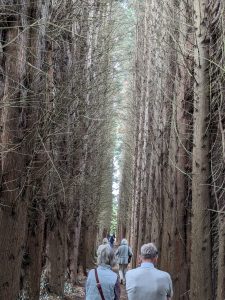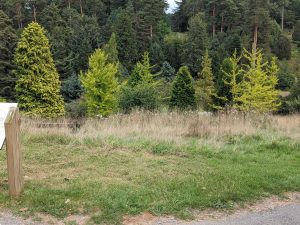
Many people visit Bedgebury every year, and probably understand that this is the National Pinetum…but do not have the pleasure and privilege of being shown around by the Curator, Dan Luscombe.
Dan has been the Curator for a number of years, and is passionate in his enthusiasm for the conifer world, visiting countries across the world to gather seed and specimens to plant at Bedgebury for sharing with other arboreta and botanical gardens. The importance of this was explained: a third of all conifer species are threatened in their natural habitats, and some species live in such restricted and precarious locations that propagation elsewhere is their best means of survival. This preservation retains genetic diversity which may help to combat the effects of climate change.
During his time as Curator, Bedgebury has moved from the original (1920’s) plan – to plant in taxonomic groups (such that, for example, all Yew species were strung out in a line). This method may be scientifically orderly, but results in risk of disease affecting all the trees very quickly and does not make for a very attractive visitor experience.
Bedgebury has adopted an approach that spreads the individual trees of one species around the Pinetum, which has the added benefit of evidencing which environment best suits that species, and mixing conifers and broadleaf species to make a more attractive picture for the visitor.
The featured photo is the view of the Pinetum from the visitor centre; this is modelled on a Japanese hillside, where conifers and other trees are intermingled – not perhaps the typical image of a pinetum.
Dan led our group of visitors onto this slope, and we stood to admire any number of different shapes, sizes and characteristics of the trees; Dan immediately gave us chapter and verse on every tree he pointed out: where and when collected and the reason for their significance.
We wondered at a Syrian Juniper (Juniperus drupacea, actually native to Greece) , which has a natural fastigiate nature and is climate change resistant; the tree Dan called the “stickle-brick” tree (actually the Spanish Fir, Abies pinsapo), which is endangered in its native country as the temperature is now too hot; a Viburnum cylindricum, whose leaves are so waxy it is possible to write on them; a 6 metre tall Wollemia pine (Wollemia nobilis) which is from Australia and is only found in a single deep cavern only a short distance from Sydney, but is now being propagated in the UK as well as elsewhere;…and too many more to list.

Given its reputation in this country, we were all impressed by the spectacular effect created by the long, tall avenue of Leylandii – a cathedral of trees!

Dan pointed out the beautiful view across the valley looking over the so-called Goldilocks Grasslands, which are wildflower meadows under a collection of golden trees.

We had covered a good deal of ground, but by no means all that might be of interest – another visit in the future is a likely plan.
A very relaxed, informative and highly enjoyable afternoon ended walking back to the Visitor Centre and departing home with many thanks to Dan for sharing his time with us.

